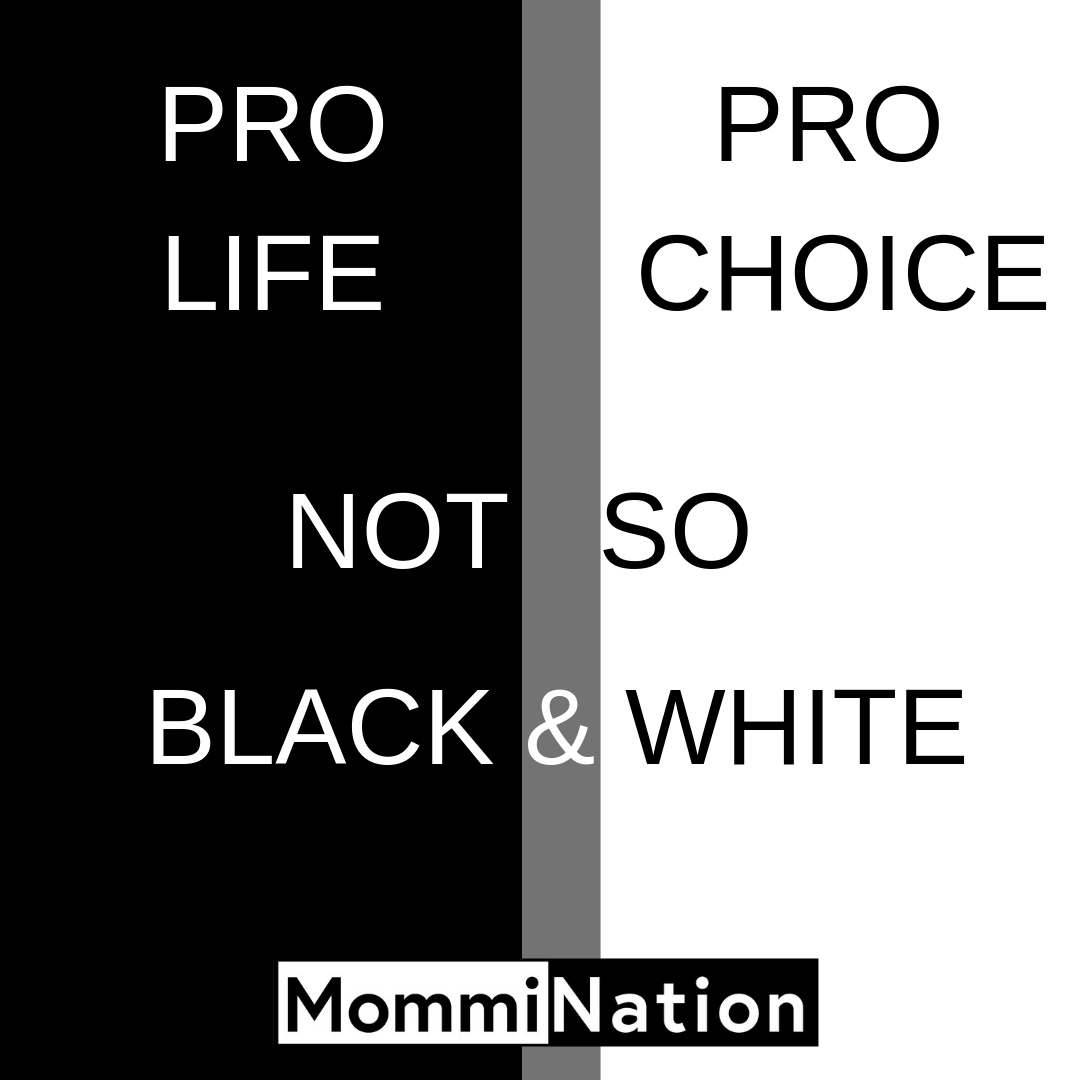What I love most about MommiNation, is that it is a community of supportive Mommies. Mommies from all different backgrounds, perspectives, and unique experiences both with similar and different opinions, with one common goal. The pro-life vs pro-choice debate has been a long-standing debate that has created division of people in all circles. And our country is no different. With the recent national news of abortion law changes, this division has become more evident. This article is intended, not to support either argument or perpetuate the division. But instead, this article is to inform the Nation of the recent activity surrounding this issue and start an open dialogue to support and respect our difference in opinions.
Abortion: Pro-Life Vs Pro-Choice
The terms “pro-life” and “pro-choice” loosely describe whether an individual believes abortion should be banned or if it is acceptable. But there is more to the debate than that. And, there is definitely a grey area.
Black – White – Grey
Pro-Choice advocates argue that choosing abortion is a right that should not be governed by federal, church, or state. The right of the woman outweighs any right claimed for an embryo or fetus. They also believe that individuals have unlimited autonomy to make decisions about their own reproductive systems, as long as they do not breach the autonomy of others.
Pro-Life advocates argue that individual human life begins at fertilization, and abortion is the immoral killing of an innocent human. Pro-life advocates also believe that it is the duty of the government to preserve all human life.
But it is not just that simple. There is also a large grey area. This grey area includes women who would never have an abortion themselves, but believe that every woman should have the power to make the ultimate decision about their bodies and their lives raising a child. The grey area includes women who have made the decision to get an abortion in the past based on circumstances, do not regret their decision, but would not make that decision again. This group also include women who have made the decision in the past but deeply regret their decision. The grey area is larger than we think. These are only a few examples of how individuals have a stance but will flex on a case by case basis.
It is obvious that this debate is a strenuous one. This is not only a debate amongst people but could also be an internal conflict within one’s self.
Background
Going back over thousands of years, abortion had been performed in every society that has been studied. In the1800s, states began passing laws that made abortion illegal. The reasons for prohibiting abortions during this time ranged from one end of the spectrum to the other.
Connecticut was the first state to pass a law in the United States barring abortions after “quickening.” This started a trickling effect and by 1910 all but one state had criminalized abortion except where necessary, in a doctor’s judgment, to save a woman’s life. Pro-choice advocates began to become more powerful and insisted abortions were legalized. Although their efforts began on a state level, the voice to the nation grew larger and larger.
In 1970, Governor Rockefeller signed a bill in NY allowing abortion on demand up to the 24th week of pregnancy. This was a domino effect and similar laws were passed in Alaska, Hawaii, and Washington state.
Roe V. Wade
In 1973 The U.S. Supreme Court rules on Roe v. Wade, finding that a “right of privacy” included a right to abortion. Roe v. Wade adopted a trimester timeline of pregnancy. In the first trimester, a state is virtually restricted from regulation. In the second trimester, the state could enforce some regulation, but only for the purpose of protecting maternal “health.” In the third trimester, a state could restrict abortion. The only exceptions were to preserve the life and “health” of the woman seeking an abortion.
Abortion: Current Day
Recently, several states passed six-week abortion bans known as the heartbeat bill. This bill prohibits abortions after six to eight weeks of pregnancy when doctors can usually start detecting a fetal heartbeat. This time period is about two weeks after a woman’s missed menstrual cycle. The states that have passed this law are Georgia, Iowa, Ohio, Kentucky, Mississippi, and North Dakota. None of these laws are in effect as of yet. On May 16, 2019, Missouri Senate passed an eight-week abortion ban currently pending the state House and governor. If passed, Missouri will be the latest state to ban abortions after a heartbeat is detected.
One of the most controversial states, Alabama, passed a near-total abortion ban. Alabama legislators voted to ban abortions in nearly all cases and will be the first outright ban on abortion. According to the Washington Post, the legislation makes exceptions only for the health of the mother. Exceptions are also made for fetuses with “fatal anomalies” that make them unlikely to survive outside the womb. Rape and incest are not exceptions to Alabama’s ban. The Alabama bill explicitly states that women are exempt from criminal and civil liability. Instead, the law targets doctors. Doctors can be prosecuted for performing an abortion, a felony punishable by up to 99 years imprisonment. The Georgia law also says that doctors who perform abortions will be prosecuted. The Georgia bill does not specifically state the consequences of women getting the abortion.

Abortion: Future State
According to CNN, Alabama’s ban is set to take effect in November 2019 and Georgia’s law on January 1, 2020. Only time will tell if those laws will come to fruition and overcome legal challenges that will likely arise. Kentucky’s bill was blocked by a federal judge. Ohio and Mississippi bans both set to take effect this summer and are currently being challenged in court.
Other states like Florida, Louisiana, Maryland, Minnesota, South Carolina, Tennessee, Texas, and West Virginia are making their way through the process. Some if these states have found it difficult to gain traction.
Protecting Abortion Rights
There have also been bills that would protect abortion rights. New York passed a law to protect women’s access to abortions. The law also protects medical professionals who perform abortions from criminal prosecution. Oregon has a state law that makes abortion legal throughout pregnancy. Other states currently only permit abortion prior to viability or to protect the health and life of a woman.
Again, this article is not intended to support one argument over the other. On the contrary, this article is intended to inform Mommies of the current events that will directly impact us. I would love to start a dialogue about where we all stand on the pro-life v. pro-choice spectrum. Are you pro-choice? Are you pro-life? Or do you stand in the middle? Why have you made that stance? Remember MommiNation is a safe place and a #NoJudgementZone. Please be respectful of others opinions and remember, we are a nation here to support and educate each other.
Until Next Time,








Tj
May 27, 2019 10:06 amI’m pro-choice, because you can’t stop abortions. All you can stop is access to safe abortions.
Roe vs Wade came about because so many women were dying from illegally induced abortions, so women fought for access to safe abortions because banning it is banning healthcare and putting women’s lives at risk.
Minority women suffred the most from abortion bans, as they don’t have the kind of access that white women have when it comes to healthcare options.
The impact on women’s health is missing from these conversations about abortion bans, and that’s largely telling of how staunch pro-life advocates feel about women.